List of major cities in East Asia.
List of major cities in East Asia.





| City | Chinese | Pinyin | Province | Population (2010) | |
|---|---|---|---|---|---|
| Urban Population (2010) | Administrative Population (2010) | ||||
| Shanghai | 上海 | Shànghǎi | Municipality | 22,315,426 | 23,019,148 |
| Beijing | 北京 | Běijīng | Municipality | 18,827,000 | 19,612,368 |
| Tianjin | 天津 | Tiānjīn | Municipality | 11,090,314 | 12,937,954 |
| Guangzhou | 广州 | Guǎngzhōu | Guangdong | 11,070,654 | 12,700,800 |
| Shenzhen | 深圳 | Shēnzhèn | Guangdong | 10,357,938 | 10,357,938 |
| Dongguan | 东莞 | Dōngguǎn | Guangdong | 8,220,937 | 8,220,937 |
| Chengdu | 成都 | Chéngdū | Sichuan | 7,123,697 | 14,047,625 |
| Nanjing | 南京 | Nánjīng | Jiangsu | 6,852,984 | 8,004,680 |
| Wuhan | 武汉 | Wǔhàn | Hubei | 6,434,373 | 9,785,392 |
| Shenyang | 沈阳 | Shěnyáng | Liaoning | 5,743,718 | 8,106,171 |
| Hangzhou | 杭州 | Hángzhōu | Zhejiang | 5,695,313 | 8,700,400 |
| Chongqing | 重庆 | Chóngqìng | Municipality | 5,402,721 | 28,846,170 |
| Suzhou | 苏州 | Sūzhōu | Jiangsu | 5,349,000 | 10,465,994 |
| Harbin | 哈尔滨 | Hārbīn | Heilongjiang | 5,282,083 | 10,635,971 |
| Jinan | 济南 | Jǐnán | Shandong | 3,922,180 | 6,814,000 |
| Xi'an | 西安 | Xī'ān | Shaanxi | 3,890,098 | 8,467,837 |
| Wuxi | 无锡 | Wúxí | Jiangsu | 3,542,319 | 6,372,624 |
| Hefei | 合肥 | Héféi | Anhui | 3,352,076 | 5,702,466 |
| Changchun | 长春 | Chángchūn | Jilin | 3,341,700 | 7,677,089 |
| Changzhou | 常州 | Chángzhōu | Jiangsu | 3,290,548 | 4,591,972 |
| Dalian | 大连 | Dàlián | Liaoning | 3,266,905 | 6,690,432 |
| Taiyuan | 太原 | Tàiyuán | Shanxi | 3,212,500 | 4,201,591 |
| Kunming | 昆明 | Kūnmíng | Yunnan | 3,184,580 | 6,432,212 |
| Zhengzhou | 郑州 | Zhèngzhōu | Henan | 3,132,000 | 8,626,505 |
| Changsha | 长沙 | Chángshā | Hunan | 3,093,980 | 7,044,118 |
| Ningbo | 宁波 | Níngbō | Zhejiang | 3,089,180 | 7,605,700 |
| Qingdao | 青岛 | Qīngdǎo | Shandong | 3,063,492 | 8,715,100 |
| Zibo | 淄博 | Zībó | Shandong | 3,002,181 | 4,530,600 |
| Fuzhou | 福州 | Fúzhōu | Fujian | 2,921,763 | 7,115,370 |
| Nanning | 南宁 | Nánníng | Guangxi | 2,875,220 | 6,661,600 |
| City | Image | Chinese | Pinyin | County | Population (2017) |
|---|---|---|---|---|---|
| New Taipei |  | 新北 | Xīnběi | Special municipality | 3,979,208 |
| Taichung |  | 臺中 | Táizhōng | Special municipality | 2,778,182 |
| Kaohsiung |  | 高雄 | Gāoxióng | Special municipality | 2,777,873 |
| Taipei |  | 臺北 | Táiběi | Special municipality | 2,695,704 |
| Taoyuan |  | 桃園 | Táoyuán | Special municipality | 2,171,127 |
| Tainan | 臺南 | Táinán | Special municipality | 1,886,267 | |
| Hsinchu |  | 新竹 | Xīnzhú | Provincial city | 439,435 |
| Keelung |  | 基隆 | Jīlóng | Provincial city | 371,853 |
| Chiayi |  | 嘉義 | Jiāyì | Provincial city | 269,608 |
| Changhua |  | 彰化 | Zhānghuà | Changhua | 234,053 |
| Pingtung |  | 屏東 | Píngdōng | Pingtung | 285,804 |
| City | image | Japanese | Prefecture | Population (2010) |
|---|---|---|---|---|
| Special wards of Tokyo |  | 東京特別区 | Tokyo | 8,949,447 |
| Yokohama | 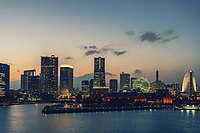 | 横浜 | Kanagawa | 3,689,603 |
| Osaka |  | 大阪 | Osaka | 2,666,371 |
| Nagoya |  | 名古屋 | Aichi | 2,263,907 |
| Sapporo |  | 札幌 | Hokkaido | 1,914,434 |
| Kobe |  | 神戸 | Hyōgo | 1,544,873 |
| Kyoto |  | 京都 | Kyoto | 1,474,473 |
| Fukuoka |  | 福岡 | Fukuoka | 1,463,826 |
| Kawasaki |  | 川崎 | Kanagawa | 1,425,678 |
| Saitama |  | さいたま | Saitama | 1,222,910 |
| Hiroshima |  | 広島 | Hiroshima | 1,174,209 |
| Sendai |  | 仙台 | Miyagi | 1,045,903 |
| Kitakyushu |  | 北九州 | Fukuoka | 977,288 |
| Chiba |  | 千葉 | Chiba | 962,130 |
| Sakai |  | 堺 | Osaka | 842,134 |
| Niigata |  | 新潟 | Niigata | 812,192 |
| Hamamatsu |  | 浜松 | Shizuoka | 800,912 |
| Kumamoto |  | 熊本 | Kumamoto | 734,294 |
| Sagamihara |  | 相模原 | Kanagawa | 717,561 |
| Shizuoka |  | 静岡 | Shizuoka | 716,328 |
| Okayama |  | 岡山 | Okayama | 709,622 |
| City | Image | Mongolian Cyrillic | Mongolian script | Province | Population (2008) |
|---|---|---|---|---|---|
| Ulan Bator |  | Улаанбаатар | ᠤᠯᠠᠭᠠᠨᠪᠠᠭᠠᠲᠤᠷ | Municipality | 1,008,738 |
| Erdenet |  | Эрдэнэт | ᠡᠷᠳᠡᠨᠢᠲᠦ | Orkhon | 86,866 |
| Darkhan |  | Дархан | ᠳᠠᠷᠬᠠᠨ | Darkhan-Uul | 74,300 |
| Choibalsan |  | Чойбалсан | ᠴᠣᠶᠢᠪᠠᠯᠰᠠᠩ | Dornod | 38,150 |
| Mörön |  | Мөрөн | ᠮᠥᠷᠡᠨ | Khövsgöl | 36,082 |
| City | Image | Chosŏn'gŭl | Hancha | Province | Population (2008) |
|---|---|---|---|---|---|
| Pyongyang |  | 평양 | 平壤 | Direct-administered city | 3,255,288 |
| Hamhung |  | 함흥 | 咸興 | South Hamgyong | 768,551 |
| Chongjin |  | 청진 | 清津 | North Hamgyong | 667,929 |
| Nampo |  | 남포 | 南浦 | Special city | 366,341 |
| Wonsan |  | 원산 | 元山 | Kangwon | 363,127 |
| Sinuiju |  | 신의주 | 新義州 | North Pyongan | 359,341 |
| Tanchon | N/A | 단천 | 端川 | South Hamgyong | 345,876 |
| Kaechon | N/A | 개천 | 价川 | South Pyongan | 319,554 |
| Kaesong |  | 개성 | 開城 | Special-level city | 308,440 |
| Sariwon |  | 사리원 | 沙里院 | North Hwanghae | 307,764 |




| City | Hangul | Hanja | Province | Population (2010) |
|---|---|---|---|---|
| Seoul | 서울 | none [1] | Special city | 9,794,304 |
| Busan | 부산 | 釜山 | Metropolitan city | 3,414,950 |
| Incheon | 인천 | 仁川 | Metropolitan city | 2,662,509 |
| Daegu | 대구 | 大邱 | Metropolitan city | 2,446,418 |
| Daejeon | 대전 | 大田 | Metropolitan city | 1,501,859 |
| Gwangju | 광주 | 光州 | Metropolitan city | 1,469,293 |
| Ulsan | 울산 | 蔚山 | Metropolitan city | 1,082,567 |
| Suwon | 수원 | 水原 | Gyeonggi | 1,071,913 |
| Changwon | 창원 | 昌原 | South Gyeongsang | 1,058,021 |
| Seongnam | 성남 | 城南 | Gyeonggi | 949,964 |
| Goyang | 고양 | 高陽 | Gyeonggi | 905,076 |
| Yongin | 용인 | 龍仁 | Gyeonggi | 856,765 |
| Bucheon | 부천 | 富川 | Gyeonggi | 853,039 |
| Ansan | 안산 | 安山 | Gyeonggi | 728,775 |
| Cheongju | 청주 | 淸州 | North Chungcheong | 666,924 |
| Jeonju | 전주 | 全州 | North Jeolla | 649,728 |
| Anyang | 안양 | 安養 | Gyeonggi | 602,122 |
| Cheonan | 천안 | 天安 | South Chungcheong | 574,623 |
| Namyangju | 남양주 | 南楊州 | Gyeonggi | 529,898 |
| Pohang | 포항 | 浦項 | North Gyeongsang | 511,390 |

South Korea, officially the Republic of Korea (ROK), is a country in East Asia. It constitutes the southern part of the Korean Peninsula and borders North Korea along the Korean Demilitarized Zone. The country's western border is formed by the Yellow Sea, while its eastern border is defined by the Sea of Japan. South Korea claims to be the sole legitimate government of the entire peninsula and adjacent islands. It has a population of 51.96 million, of which roughly half live in the Seoul Capital Area, the fourth most populous metropolitan area in the world. Other major cities include Incheon, Busan, and Daegu.

The 1988 Summer Olympics, officially known as the Games of the XXIV Olympiad and commonly known as Seoul 1988, was an international multi-sport event held from 17 September to 2 October 1988 in Seoul, South Korea. 159 nations were represented at the games by a total of 8,391 athletes. 237 events were held and 27,221 volunteers helped to prepare the Olympics.
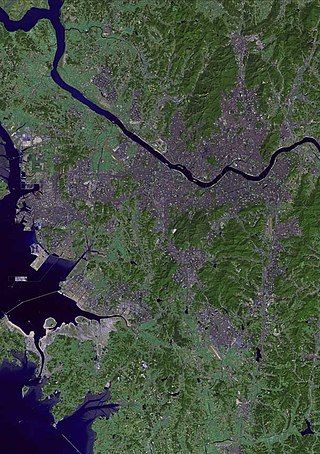
The Han River or Hangang is a major river in South Korea. While most of it is in South Korea, some of its tributaries are in North Korea. It is the fourth longest river on the Korean peninsula after the Yalu ("Amnok"), Tumen ("Tuman"), and Nakdong rivers. The river begins as two smaller rivers in the eastern mountains of the Korean peninsula, which then converge near Seoul, the capital of the country.

Incheon International Airport (Korean: 인천국제공항) is the largest airport in South Korea. It is the primary airport serving the Seoul Capital Area and one of the largest and busiest airports in the world.

Seoul National University is a national research university located in Seoul, South Korea. Founded in 1946, Seoul National University is widely regarded as the most prestigious university in South Korea.

The Seoul Metropolitan Subway is a metropolitan railway system consisting of 23 rapid transit, light metro, commuter rail and people mover lines located in northwest South Korea. The system serves most of the Seoul Metropolitan Area including the Incheon metropolis and satellite cities in Gyeonggi province. Some regional lines in the network stretch out beyond the Seoul Metropolitan Area to rural areas in northern Chungnam province and western Gangwon province, that lie over 100 km (62 mi) away from the capital.

Gyeonggi Province is the most populous province in South Korea. Its name, Gyeonggi, means "京 and 畿 ". Thus, Gyeonggi-do can be translated as "Seoul and the surrounding areas of Seoul". Seoul, the nation's largest city and capital, is in the heart of the area but has been separately administered as a provincial-level special city since 1946. Incheon, the nation's third-largest city, is on the coast of the province and has been similarly administered as a provincial-level metropolitan city since 1981. The three jurisdictions are collectively referred to as Sudogwon and cover 11,730 km2 (4,530 sq mi), with a combined population of over 26 million - amounting to over half (50.25%) of the entire population of South Korea at the 2020 Census.

The Seoul World Cup Stadium (Korean: 서울월드컵경기장), also known as Sangam Stadium, is a stadium used mostly for association football matches. The venue is located in 240, World Cup-ro, Mapo-gu, Seoul, South Korea. It was built for the 2002 FIFA World Cup and opened on November 10, 2001. It is currently the second largest stadium in South Korea after Seoul Olympic Stadium, and is the 2nd largest rectangular stadium in Asia. It was designed to represent the image of a traditional Korean kite. The stadium has a capacity of 66,704 seats, including 816 seats for VIP, 754 seats for press and 75 private Sky Box rooms, each with a capacity for 12 to 29 persons. Due to table seats installation, capacity was reduced from 66,806 seats to 66,704 seats in February 2014. Since the World Cup it has been managed by the Seoul Metropolitan Facilities Management Corporation (SMFMC). FC Seoul moved to the Seoul World Cup Stadium in 2004.
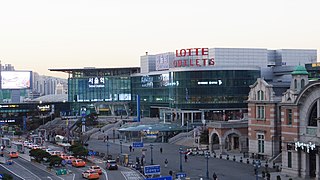
Seoul Station is a major railway station in Seoul, the capital of South Korea. The station is served by the Korail Intercity Lines and the commuter trains of the Seoul Metropolitan Subway.

FC Seoul is a South Korean professional football club based in Seoul that competes in the K League 1, the top flight of South Korean football. The club is owned by GS Sports, a subsidiary of GS Group. Since 2004, FC Seoul have played its home games at the Seoul World Cup Stadium in Seoul's Mapo District.
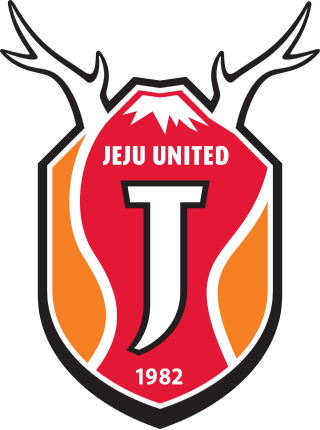
Jeju United Football Club is a South Korean professional football club based in Jeju Province that competes in the K League 1, the top division in South Korea. In the past, the club has been known as the Yukong Elephants and Bucheon SK.
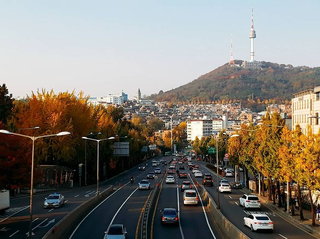
Yongsan District is one of the 25 districts of Seoul, South Korea.
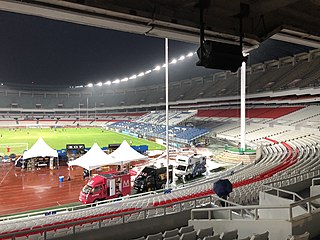
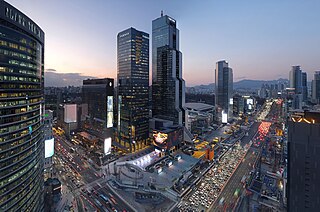
Gangnam District is one of the 25 districts of Seoul, South Korea. The term Gangnam translates to "South of the [Han] River". Gangnam District is the third largest district in Seoul, with an area of 39.5 km2 (15.3 sq mi). As of the 2017 census, Gangnam District had a population of 561,052. There is a high concentration of wealth in the district, with prices for an apartment as of 2020 nearly double those in the rest of Seoul. Gangnam District is part of Gangnam School District Eight, along with the Seocho District. This district shares half of Gangnam-daero Gangnam Station area with Seocho District, which is one of the most crowded places in South Korea.
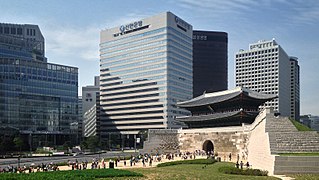
Jung District is one of the 25 districts of Seoul, South Korea.

Seoul has been known in the past by successive names, including Wiryeseong and Hanseong, Bukhansangun, Hanyang, Namgyeong, Hanyangbu, Hanseong and Hanyang. During the Joseon era, it started to be called Seoul by the public. In the middle of Joseon era, Hanseong and Hanyang were almost replaced by Seoul and remained only formal names. During the period of Japanese colonial rule, Seoul was referred to by the Japanese exonym Keijō, or Gyeongseong in Korean. After World War II and Korea's liberation, the city took its familiar name, Seoul.
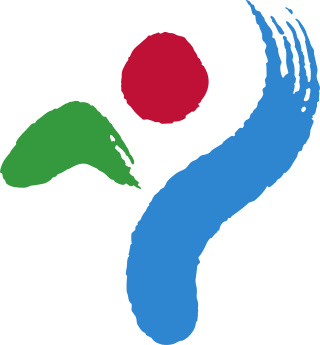
The Seoul Metropolitan Government is a local government of Seoul, South Korea. The mayor is elected to a four-year term by the citizens of Seoul and is responsible for the administration of the city government. The Seoul Metropolitan Government deals with administrative affairs as the capital city of South Korea. Hence, it is more centralized than that of most other cities, with the city government being responsible for correctional institutions, public education, libraries, public safety, recreational facilities, sanitation, water supply, and welfare services.

Seoul, officially known as the Seoul Special City, is the capital and largest metropolis of the Republic of Korea. According to the 2020 census, Seoul has a population of 9.9 million people, and forms the heart of the Seoul Capital Area with the surrounding Incheon metropolis and Gyeonggi province. Considered to be a global city and rated as an Alpha – City by Globalization and World Cities Research Network (GaWC), Seoul was the world's fourth largest metropolitan economy in 2014, following Tokyo, New York City and Los Angeles.

The Seoul Music Awards is a major South Korean music awards show presented by the newspaper Sports Seoul. The award winners are selected based on a combination of criteria, including music sales, popular votes, and expert judges' opinions.

The Seoul Capital Area (SCA), Sudogwon or Gyeonggi region, is the metropolitan area of Seoul, Incheon, and Gyeonggi Province, located in north-west South Korea. Its population of 26 million is ranked as the fourth largest metropolitan area in the world. Its area is about 12,685 km2 (4,898 sq mi). It forms the cultural, commercial, financial, industrial, and residential center of South Korea. The largest city is Seoul, with a population of approximately 10 million people, followed by Incheon, with 3 million inhabitants.